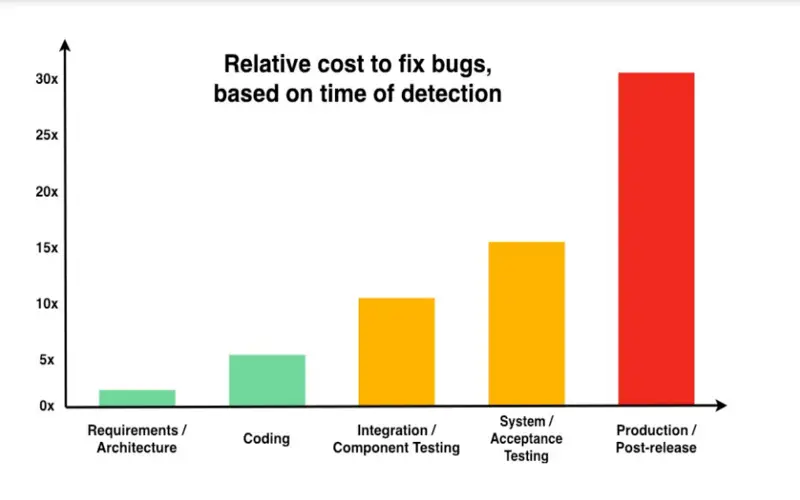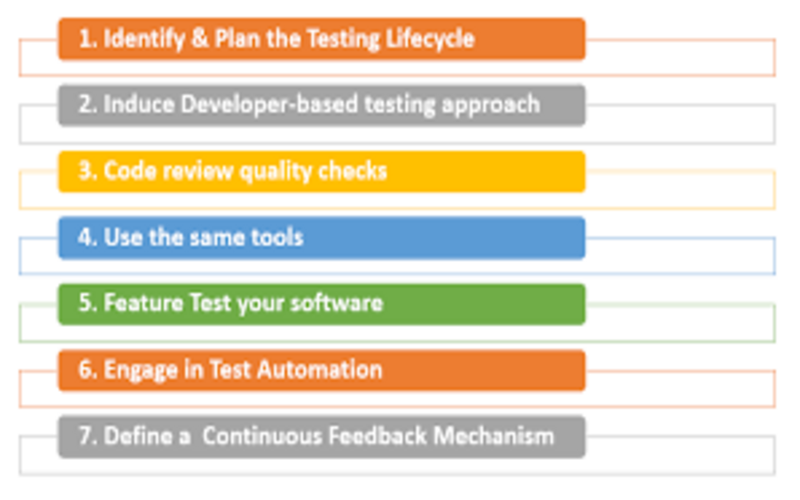
Specify Quality Standards
Enhanced Design
Bugs Are Fixed Early On
Enormous Time And Effort Saved
Early Bug Detection Ensures Good Code And Product Quality
Include Testers Before On For Planning And Evaluation
Faster Time-to-Release
Helps Reshape Product Development
United Test Method
Less Waiting In Testing Action
Testing accesses the picture at the very end or to the high right of the pipeline. Shift-left Testing generally pushes testing to the “left,” that is, before stages in the pipeline. The shift left reached aims to recognize bugs as early as possible in the development procedures. It enhances software measurement and minimizes time spent determining errors (which generally magnifies as development progresses) later in the pipeline. It translates to more tests being started by programmers before they push their isolated code units to version control.
“Shift left” is a practice in software development in which groups focus on measuring, work on problem avoidance instead of evaluation, and begin testing before ever earlier. The purpose of the shift Left Testing to maximise quality by shortening test cycles and lowering the likelihood of an unpleasant gift at the end of the development cycle in formation.
Shifting left needs two critical DevOps practices:
Manufacturing software that is perfect for users is not a cakewalk. It takes enough time, effort, and resources. Meeting the budget and release schedule, in particular, is frequently complicated when sending software. Suitable organizing and testing techniques are often the key to determining this error. In this agile environment, managing is thus concentrating on moving quicker by reducing the length of time for delivery while continuing to enhance the quality of each release. In addition, they are facing difficulties in decreasing testing costs. As a result, numerous organizations are adopting agile reaches where distinct testers with multiple skill sets participate in the testing procedures at the previous level. This movement is widely referred to as “shifting Left”.
The devs are generally trained in testing from eliminate. Therefore, they cannot be expected to figure out the finer points of testing automatically. QAs and QA organizations should explain the quality, performance, and operational achievement expected from the code so that developers who begin testing know what bugs to look for. They must have a lucid idea of what may be on-negotiable and what errors can be promoted to QAs. QAs and QA organizations should explain the level of quality, performance, and operational achievement expected from the code so that developers who begin testing know the bugs to look for.

Through consistent Shift-Left testing and laborious brainstorming sessions, roadblock regions, bottlenecks, and probable performance failures were recognized in the newest. Even though this detection may lead to the latest design options, they improve various of the absolute idea.

Reviewing how management directors generally confess that they “should have” organized the error early on when it was recognized, we have insights into the essentials of Shift-Left testing. It allows you more breathing room to control mistakes after they have occurred, so eliminating the outlook.

When explaining the advancement of productivity and increase in grades, it would be unattainable to hope to achieve those aims without preserving time and exercise. It is another powerful reason to shift testing left.

The shift-left extends stratify that there is prompt conveying between numerous project representatives. Programmers can describe the evolution of unit tests and structure tests. Mechanical is a significant part of Shift-left examining, and with the automatic word, test groups can operate examining for a few minutes each day. Their item advice in the shape of defects is iterated and applied to the thing evolved passage, which supports adjusting and adapting the code. It shows that the overall code quality would be good with the tight code quality verification, ensuring a more comfortable end-product sent to the users.

To shift left, we should include analyses before on the arranging platform. They can offer advice on the analyzing possibility of the sketch and offer an insert on energy inspecting schemes. If there are any obscure needs, gaps in needs, or variables that may slow down testing, QA groups can point out them so that no unessential back-and-forth communication occurs later.

More minor bugs, minor rework, Quicker fixes, all of these parts authorize evolved groups to encourage the software-free manner. And prompt frees translate in to facilitate. But for groups to grasp the shift procedures, multiple products must first occur to succeed.

Shift left in analyzes doesn’t mean that we are not inspecting in the creation or that analyzes is ideally relocated to the patterned platform of the evolved life cycle. Some testing still happens at the end but should be fragmented.

With a unified test method, you can analyze limitations on automation, stubs, and climates and analyze data, reassuring that the distinct groups can encounter the needs. As usual, this is an extreme platform reached for end-to-end analyses, from unit tests to user approval evaluation (UAT) to achievement readiness tests and post-deployment tests. This technique will cover all QA responses and steps.

As a rule, after relocating to the left, you are forecasted to have depended relevant to analyzing actions. In standards, non-active settings, testers have to wait until programmers are finished executing their quality to be able to start the analyzing movement. When you shift left, analyzing becomes a before and constant movement. Testing occurs early, during, and after evolution. As usual, this implies less time spent watching and analyzing.

LATEST TECHNOLOGY ARTICLES
LATEST TECHNOLOGY NEWS